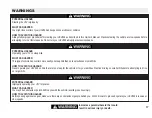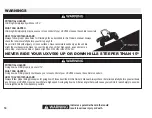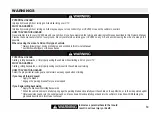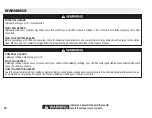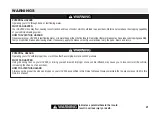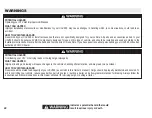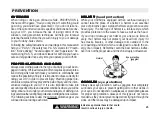
23
Indicates a potential hazard that could
result in serious injury or death.
PREVENTION
OVER
OVER
OVER
OVER
OVERVIEW
VIEW
VIEW
VIEW
VIEW
When riding or driving an off-road vehicle, PREVENTION is
the name of the game. "Had you only known" something could
go wrong, you would have prevented it. If you do not take no-
tice of the current terrain and its specific conditions before driv-
ing your UTV, you increase the risk of losing control of the
situation. Using prevention techniques will help you forecast
potential hazards before they result in injury to you or damage
to your Side-by-Side vehicle.
Following the safety instructions and warnings in this manual will
help you "P.A.S.S." the safety test. P.A.S.S. stands for "Preven-
tion," "Active Driving," "Sound Judgment," and "Supervision." Re-
membering P.A.S.S. and what it stands for will help you have a
safe and enjoyable drive every time you operate your UXV500.
PR
PR
PR
PR
PROPER CL
OPER CL
OPER CL
OPER CL
OPER CLO
O
O
O
OTHING
THING
THING
THING
THING AND GEAR
AND GEAR
AND GEAR
AND GEAR
AND GEAR
Always wear clothing suited to the type of activity you will be en-
gaged in doing. Off-road recreation often requires special protec-
tive clothing which will both make you feel more comfortable and
reduce the possibility of injury. It is important to dress correctly for
riding your UTV in order to prevent injury. Practicing proper pre-
vention is simple and may prevent the pain of injury and the incon-
venience damage to your UTV. It is also important to take into
account specific climate and weather conditions where you will be
riding. Wear a liner under your helmet and layers of clothing dur-
ing cooler weather and lighter, protective clothing when it is warmer.
The following sections review the minimum protective gear you
will need to wear during each drive.
HELMET
HELMET
HELMET
HELMET
HELMET (head protection)
While your UXV500 is equipped with an overhead canopy, it
cannot take the place of a helmet. A helmet is an essential
piece of protective gear. A proper helmet can prevent a severe
head injury. The best type of helmet is a full-face style which
provides protection to the wearer's face as well as the head.
If you drop or damage your helmet, get a new one immedi-
ately. Your helmet may not protect your head from injury if it
has cracks, fissures, or other damage to its outside or to the
core padding and liner (which are designed to absorb the en-
ergy of an impact). Remember, even the best helmet is ineffec-
tive if it is not the proper size and the chin strap is not fastened.
Eye protection
(goggles)
Helmet
GOGGLES
GOGGLES
GOGGLES
GOGGLES
GOGGLES
(eye protection)
Always wear eye protection, such as goggles, that completely
surrounds your eyes to prevent getting dirt or other debris in
your eyes. Do not depend on sunglasses or prescription glasses
for proper eye protection. Glasses of this type are not recom-
mended as they do not prevent objects from flying in through the
sides, and the lenses may be damaged upon impact.
Summary of Contents for UXV500
Page 63: ...61 PERIODIC MAINTENANCE SCHEDULE Continued on following page ...
Page 64: ...62 PERIODIC MAINTENANCE SCHEDULE Continued on following page ...
Page 83: ...81 EPA EMISSION WARRANTY ...
Page 84: ...82 MAINTENANCE RECORD DATE MILEAGE SERVICE PERFORMED NOTES ...
Page 85: ...83 MAINTENANCE RECORD DATE MILEAGE SERVICE PERFORMED NOTES ...









